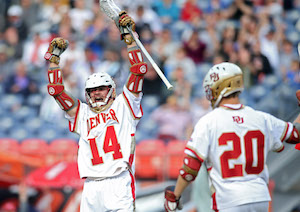Back in 2009, when the DU men’s lacrosse program was at a crossroads, athletic director Peg Bradley-Doppes did what every sports organization that wants to win should do – she shoved all her chips to the center of the table and boldly let ‘er ride.
She was all in.
Six years later – yesterday in Philadelphia – Bradley-Doppes watched her men’s lacrosse program make history. By beating Maryland 10-5 in the title game, the University of Denver became the first school not located in the Eastern Time Zone to win an NCAA national championship in lacrosse. The victory marked the institution’s 30th national championship and head coach Bill Tierney’s seventh, a record for NCAA lacrosse coaches.
But the decision to bring in Tierney back in the summer of 2009 – one that now looks like a no-brainer – was the genesis for the history-making day. It was bold. It was brash. It was considered a long shot by anyone amidst the power structure of lacrosse.
And it was expensive.
That was really the only way. Why would Tierney, a coach who was already a legend in the game, want to head west? What did he have to prove? Tierney was one of winningest coaches in college sports history and a member of the U.S. Lacrosse Hall of Fame. He’d been named National Coach of the Year on two separate occasions and had taken his teams to the NCAA Division I national tournament 20 times as a head coach, 11 of which resulted in Final Four appearances.
Plus, he already had a job at Princeton, where he’d won six national championships. By nearly all accounts, Tierney was an impossible hire for DU.
Until, that is, Bradley-Doppes made him the highest-paid coach in Division I lacrosse before he ever stepped foot on campus.
It was widely reported that Tierney would be making upwards of $250,000 at the time of his hiring, placing atop the list within his sport. While school policy dictated that the financial matters of coaches were not to be released, Bradley-Doppes did not deny the estimates.
“My guess is that’s certainly possible, and most likely probable, with the success at the camps and clinics he’s had,” Bradley-Doppes told the Denver Post regarding Tierney’s status as the highest-paid coach in lacrosse.
Still, a quarter-million to a lacrosse coach? That seemed like crazy money. Besides, it wasn’t as it if DU was a terrible program under previous coach Jamie Munro – quite the contrary. Munro, who took over the program in 1999, when it first entered the Division I ranks, was largely successful. He’d posted a 90-70 record and guided DU to two separate NCAA Tournament appearances. Not bad for a startup program west of the Mississippi.
But before the decision to bring in Tierney, the school had already begun its commitment to lacrosse, then (and perhaps still) considered a non-revenue generating sport. Beyond his hefty compensation, Tierney had one of the best facilities in the country at his disposal. Four years prior to his hiring, DU had invested heavily in Peter Barton Lacrosse Stadium, a 2,000-seat, on campus, sport-specific venue.
Bradley-Doppes and her school were all-in indeed, and the investment paid immediate dividends. In his first season in Denver, Tierney guided the Pioneers to a 12-5 record, an ECAC regular season title and a trip to the NCAA Tournament. Since his arrival at DU, the coach has never missed the tourney, has claimed five conference championships and has advanced to the Final Four four times.
Perhaps there’s a lesson to be learned: Go big or go home.
Bradley-Doppes and DU provide the latest example, but there are countless others in college and pro sports. When teams want to go from mediocre to great, there’s no messing around.
John Calipari to Kentucky. Urban Meyer to Ohio State. The Big Three to Miami. Peyton Manning to Denver.
Sure, the stakes are high, but generally speaking, when the commitment is there, so too are the results. Look back at Alabama football.
Before Nick Saban, the Tide was pretty mediocre – just five winning seasons in the 10 years prior to his arrival. With Saban? Eight bowl games, three BCS Championships and a whole bunch of time spent as the nation’s No. 1 ranked team.
Or look forward. Just watch what happens at Michigan, where the Wolverines just hired Jim Harbaugh.
Granted, the landscape of Division I college football is much different than lacrosse, but everything is relative. There are plenty of examples of success utilizing the same formula employed by DU, the stakes are just higher. There are no guarantees in sports, but there is plenty of evidence that a commitment to greatness can result in great things.
Peg Bradley-Doppes can attest to that.
